Belkin F5D7634V2 G Wireless Modem Router User Manual Manual 1 Part 1
Belkin International, Inc. G Wireless Modem Router Manual 1 Part 1
Belkin >
Contents
- 1. Manual 1 Part 1
- 2. Manual 1 Part 2
- 3. Manual 2 Part 1
- 4. Manual 2 Part 2
Manual 1 Part 1
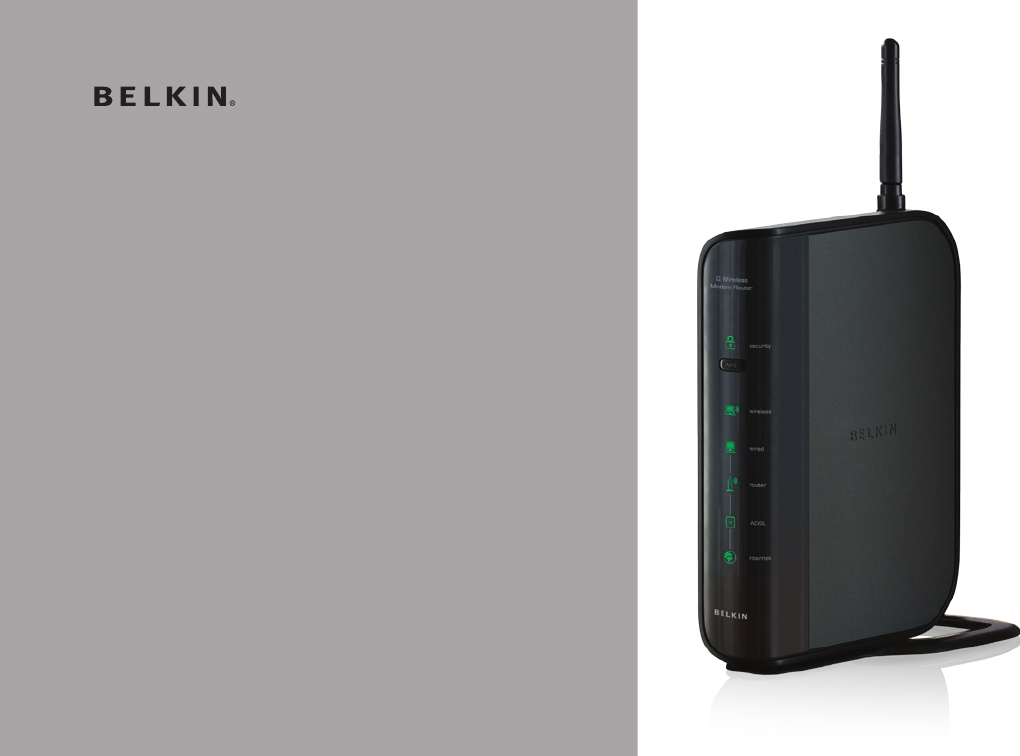
G Wireless
Modem Router
User Manual
PM01218ea-B F5D7634-4 English
Français
DEutsch
nEDErlanDs
Español
italiano
v2

i
G Wireless Modem Router
SECTIONS 12345678910Table of Contents
TABLE OF CONTENTS
� � � � � � � � � � � � � � � � � � � � � � � � � � � � � � � � � � � � � � � � � � � � � � � � � � � � � � � �34
Wireless Range Extension and Bridging � � � � � � � � � � � � � � � � � � � � � � �40
Firewall� � � � � � � � � � � � � � � � � � � � � � � � � � � � � � � � � � � � � � � � � � � � � � � � � �42
Utilities � � � � � � � � � � � � � � � � � � � � � � � � � � � � � � � � � � � � � � � � � � � � � � � � � � 48
6 Manually Configuring Network Adapters. . . . . . . . . . . . . . . . . . .57
7 Recommended Web Browser Settings . . . . . . . . . . . . . . . . . . . .62
8 Troubleshooting . . . . . . . . . . . . . . . . . . . . . . . . . . . . . . . . . . . . . . . .64
Technical-Support Information� � � � � � � � � � � � � � � � � � � � � � � � � � � � � � �76
9 Appendixes . . . . . . . . . . . . . . . . . . . . . . . . . . . . . . . . . . . . . . . . . . . .77
Appendix A: Glossary � � � � � � � � � � � � � � � � � � � � � � � � � � � � � � � � � � � � � �77
Appendix B: Important Factors for Placement and Setup � � � � � � � � �83
10 Information . . . . . . . . . . . . . . . . . . . . . . . . . . . . . . . . . . . . . . . . . . .86
1 Introduction . . . . . . . . . . . . . . . . . . . . . . . . . . . . . . . . . . . . . . . . . . . .1
Product Features� � � � � � � � � � � � � � � � � � � � � � � � � � � � � � � � � � � � � � � � � � � 2
Benefits of a Home Network� � � � � � � � � � � � � � � � � � � � � � � � � � � � � � � � � �4
Advantages of a Belkin Wireless Network � � � � � � � � � � � � � � � � � � � � � � �4
2 Make Sure You Have the Following. . . . . . . . . . . . . . . . . . . . . . . . .5
Package Contents � � � � � � � � � � � � � � � � � � � � � � � � � � � � � � � � � � � � � � � � � � 5
System Requirements� � � � � � � � � � � � � � � � � � � � � � � � � � � � � � � � � � � � � � �5
Setup Assistant Software System Requirements � � � � � � � � � � � � � � � � � 5
Internet Connection Settings � � � � � � � � � � � � � � � � � � � � � � � � � � � � � � � � �6
3 Knowing your Router. . . . . . . . . . . . . . . . . . . . . . . . . . . . . . . . . . . . .7
4 Connecting and Configuring your Router . . . . . . . . . . . . . . . . . . 11
Step 1: Hardware Connections � � � � � � � � � � � � � � � � � � � � � � � � � � � � � � 11
Step 1�1: Brand-New Setup � � � � � � � � � � � � � � � � � � � � � � � � � � � � � � � 12
Step 1�2: Replacing an Existing Modem or Modem Router � � � � � � 13
Step 2: Set Up the Router – Run the Setup Assistant Software� � � � � 14
5 Manually Configuring your Router . . . . . . . . . . . . . . . . . . . . . . . .22
Understanding the Web-Based User Interface � � � � � � � � � � � � � � � � � �22
Changing LAN Settings� � � � � � � � � � � � � � � � � � � � � � � � � � � � � � � � � � � � �25
DHCP Client List � � � � � � � � � � � � � � � � � � � � � � � � � � � � � � � � � � � � � � � � � �27
Internet WAN � � � � � � � � � � � � � � � � � � � � � � � � � � � � � � � � � � � � � � � � � � � � �27
Connection Type � � � � � � � � � � � � � � � � � � � � � � � � � � � � � � � � � � � � � � � � � �27
Wireless � � � � � � � � � � � � � � � � � � � � � � � � � � � � � � � � 32Encryption/Security

1
G Wireless Modem Router
SECTIONSTable of Contents 23456789101
INTRODUCTION
Thank you for purchasing the Belkin G Wireless Modem Router (the Router)� In minutes you will be able to share your Internet
connection and network your computers with your new Router� The following is a list of features that make your Router an ideal
solution for your home or small office network� Please be sure to read through this User Manual completely, and pay special
attention to Appendix B entitled “Important Factors for Placement and Setup”�

2
G Wireless Modem Router
SECTIONSTable of Contents 23456789101
INTRODUCTION
Product Features
Compatibility with both PCs and Mac® Computers
The Router supports a variety of networking environments including
Mac OS® 8�x, 9�x, X v10�x, AppleTalk® , Linux® , Windows® 95, 98SE,
Me, NT® , 2000, XP, Vista® , and others� You need an Internet browser
and a network adapter that supports TCP/IP (the standard language of
the Internet)�
Front-Panel LED Display
Lighted LEDs on the front of the Router indicate which functions are in
operation� You’ll know at-a-glance whether your Router is connected to
the Internet� This feature eliminates the need for advanced software and
status-monitoring procedures�
Web-Based Advanced User Interface
You can set up the Router’s advanced functions easily through your web
browser, without having to install additional software onto the computer�
There are no disks to install or keep track of and, best of all, you can
make changes and perform setup functions from any computer on the
network quickly and easily�
Integrated 10/100 4-Port Switch
The Router has a built-in, 4-port network switch to allow your wired
computers to share printers, data and MP3 files, digital photos, and
much more� The switch features automatic detection so it will adjust to
the speed of connected devices� The switch will transfer data between
computers and the Internet simultaneously without interrupting or
consuming resources�
Integrated 802.11g Wireless Access Point
802�11g is an exciting new wireless technology that achieves data rates
up to 54Mbps, nearly five times faster than 802�11b�
Built-In Dynamic Host Configuration Protocol (DHCP)
Built-In Dynamic Host Configuration Protocol (DHCP) on-board makes
for the easiest possible connection of a network� The DHCP server will
assign IP addresses to each computer automatically so there is no need
for a complicated networking setup�

3
G Wireless Modem Router
SECTIONSTable of Contents 23456789101
INTRODUCTION
NAT IP Address Sharing
Your Router employs Network Address Translation (NAT) to share the
single IP address assigned to you by your Internet Service Provider
while saving the cost of adding additional IP addresses to your Internet
service account�
SPI Firewall
Your Router is equipped with a firewall that will protect your network
from a wide array of common hacker attacks including IP Spoofing,
Land Attack, Ping of Death (PoD), Denial of Service (DoS), IP with zero
length, Smurf Attack, TCP Null Scan, SYN flood, UDP flooding, Tear
Drop Attack, ICMP defect, RIP defect, and fragment flooding�
MAC Address Filtering
For added security, you can set up a list of MAC addresses (unique
client identifiers) that are allowed access to your network� Every
computer has its own MAC address� Simply enter these MAC addresses
into a list using the web-based user interface and you can control
access to your network�
Universal Plug-and-Play (UPnP) Compatibility
UPnP (Universal Plug-and-Play) is a technology that offers seamless
operation of voice messaging, video messaging, games, and other
applications that are UPnP-compliant�
Support for VPN Pass-Through
If you connect to your office network from home using a VPN
connection, your Router will allow your VPN-equipped computer to pass
through the Router and to your office network�

4
G Wireless Modem Router
SECTIONSTable of Contents 23456789101
INTRODUCTION
Advantages of a Wireless Network
Mobility – you’ll no longer need a dedicated “computer room”—now you
can work on a networked laptop or desktop computer anywhere within
your wireless range
Easy installation – Belkin’s Setup Wizard makes setup simple
Flexibility – set up and access printers, computers, and other
networking devices from anywhere in your home
Easy expansion – the wide range of Belkin networking products let
you expand your network to include devices such as printers and
gaming consoles
No cabling required – you can spare the expense and hassle of
retrofitting Ethernet cabling throughout the home or office
Widespread industry acceptance – choose from a wide range of
interoperable networking products
Benefits of a Home Network
By following our simple setup instructions, you will be able to use your
Belkin home network to:
• Share one high-speed Internet connection with all the computers in
your home
• Share resources, such as files, and hard drives among all the
connected computers in your home
• Share a single printer with the entire family
• Share documents, music, video, and digital pictures
• Store, retrieve, and copy files from one computer to another
• Simultaneously play games online, check Internet email, and chat

5
G Wireless Modem Router
SECTIONSTable of Contents 1 345678910
MAKE SURE YOU HAVE THE FOLLOWING
2
Package Contents
• G Wireless Modem Router
• Quick Installation Guide
• RJ11 Telephone Cord – Gray
• RJ45 Ethernet Networking Cable – Yellow
• ADSL Micro Filter*
• Power Adapter
• User Manual and Belkin Setup Assistant Software on CD-ROM
*ADSL micro filter varies by country� If it’s not included, you will need to
purchase one�
System Requirements
• An active ADSL service with a telephone wall jack for connecting
the Router
• At least one computer with a Network Interface Card (NIC) and
Internet browser installed and correctly configured
• TCP/IP networking protocol installed on each computer connected
to the Router
• No other DHCP server on your local network assigning IP
addresses to computers and devices
Setup Assistant Software System Requirements
• A PC running Windows® 2000, XP, or Vista®; or Mac OS® X
v10�4, v10�5
• Minimum 500MHz processor and 128MB RAM
• Internet browser

6
G Wireless Modem Router
SECTIONSTable of Contents 1 3456789102
MAKE SURE YOU HAVE THE FOLLOWING
Internet Connection Settings
The Setup Assistant contains a database of Internet Service Providers (ISPs) in each country to help you set up your Router quickly� If your ISP is not
on the list, please collect the following information from your ISP before setting up the Router:
• Internet connection protocol: (PPPoE, PPPoA, Dynamic IP, Static IP)
• Multiplexing method or Encapsulation: (LLC or VC MUX)
• Virtual circuit: VPI (Virtual Path Identifier) __________ (a number between 0 and 255)
• VCI (Virtual Channel Identifier) __________ (a number between 1 and 65535)
• For PPPoE and PPPoA users: ADSL account user name and password _______________
• For static IP users: IP Address ___ � ___ � ___ � ___
Subnet Mask ___ � ___ � ___ � ___
Default Gateway Server ___ � ___ � ___ �
• IP address for Domain Name Server ___ � ___ � ___ � ___ (If given by your ISP)
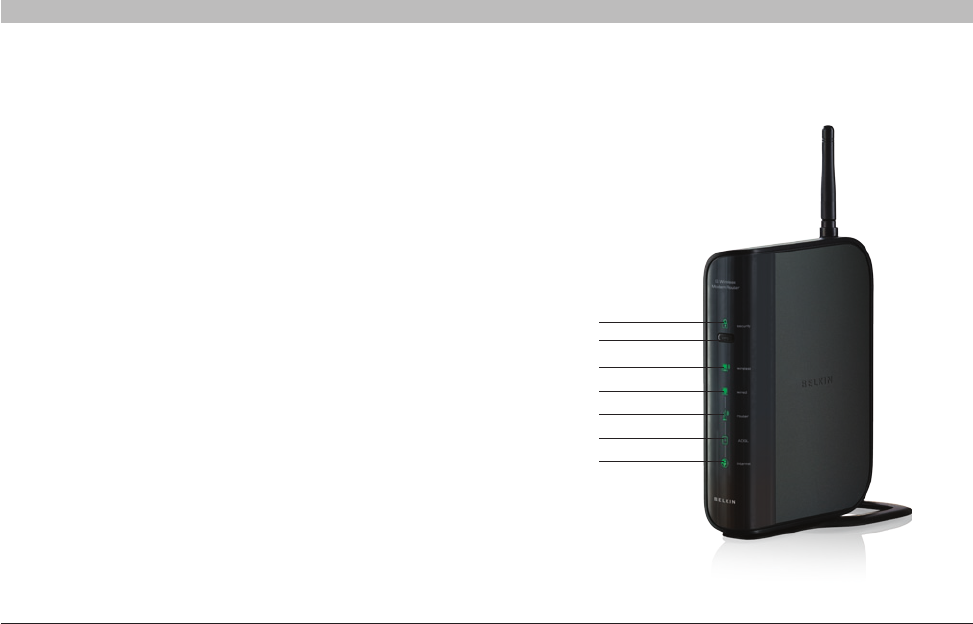
7
G Wireless Modem Router
SECTIONSTable of Contents 12 45678910
KNOWING YOUR ROUTER
3
Knowing your Router
The Router has been designed to be placed on a desktop� All of the
cables exit from the rear of the Router for better organization and utility�
The Network Status Display is easily visible on the FRONT of the Router
to provide you with information about network activity and status� See
the Network Status Display Guide for more detailed information�
(A)
(B)
(C)
(D)
(E)
(F)
(K)
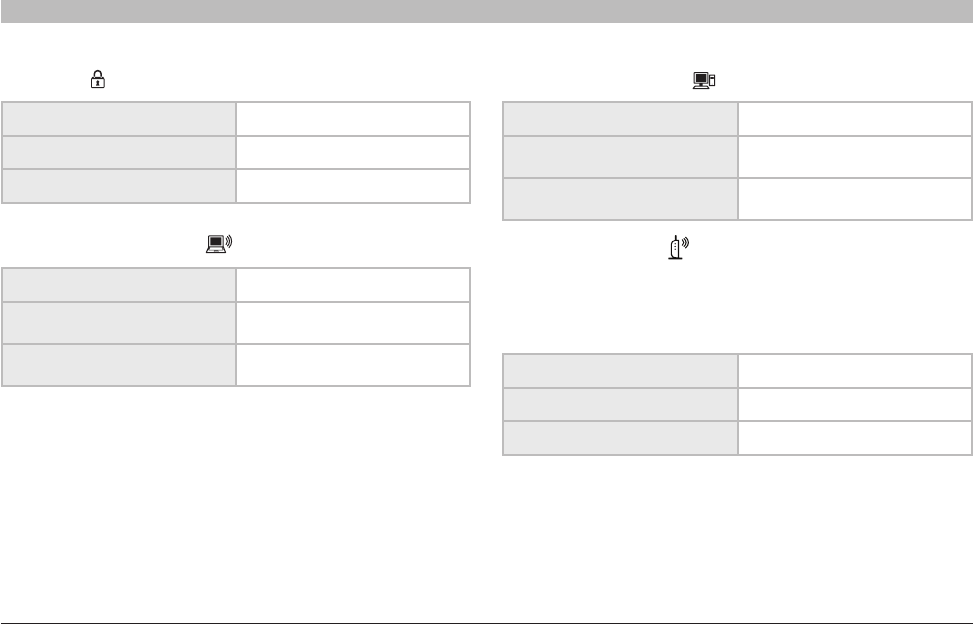
8
G Wireless Modem Router
SECTIONSTable of Contents 12 456789103
KNOWING YOUR ROUTER
C. Wired-Computer Status
A. Security
OFF Wireless security is OFF
Solid Green Wireless security is ON
Flashing Green WPS sync is in progress
OFF Wireless computer is not present
Solid Green Wireless computer is connected
to the Router
Blinking Amber Problem with wireless computer
connecting properly to the Router
B. Wireless-Computer Status
OFF Wired computer is not present
Solid Green Wired computer is connected to
the Router
Blinking Amber Problem with wired computer
connecting to the Router
D. Router/Power Status
When you apply power to the Router or restart it, a short period of time
elapses while the Router boots up� During this time, the “router” icon
blinks� When the Router has completely booted up, the “router” icon
becomes a solid light, indicating the Router is ready for use�
OFF Router is off
Blinking Green Router is booting up
Solid Green Router is on and ready
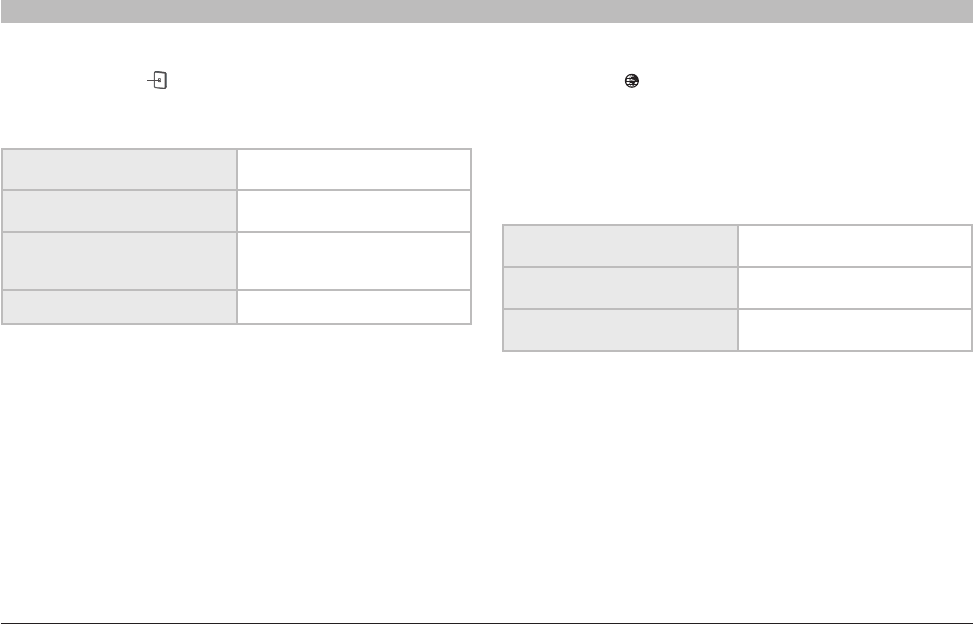
9
G Wireless Modem Router
SECTIONSTable of Contents 12 456789103
KNOWING YOUR ROUTER
E. ADSL Line Status
This icon lights in green to indicate that your modem is connected
properly to the Router� It turns amber when problem is detected�
F. Internet Status
This unique icon shows you when the Router is connected to the
Internet� When the light is off, the Router is NOT connected to the
Internet� When the light is blinking amber, the Router is attempting to
connect to the Internet� When the light is solid green, the Router is
connected to the Internet� When using the “Disconnect after x minutes”
feature, this icon becomes extremely useful in monitoring the status of
your Router’s connection�
OFF Router is NOT connected to the
Internet
Blinking Green Router is attempting to connect
to the Internet
Solid Green Router is connected to
the Internet
OFF Router is NOT connected to a
functioning ADSL line
Blinking Green Router is attempting to connect
to the ADSL line
Solid Green Router is connected to an
ADSL service and is functioning
properly
Blinking Amber Problem with ADSL line
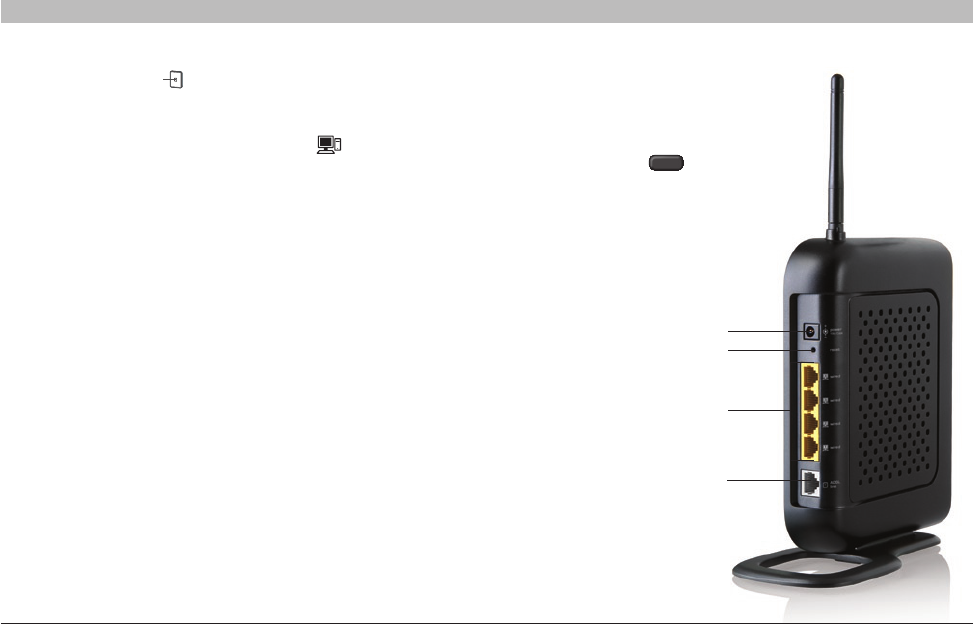
10
G Wireless Modem Router
SECTIONSTable of Contents 12 456789103
KNOWING YOUR ROUTER
(I)
(G)
(J)
(H)
G. Connection to ADSL – Gray
This port is for connection to your ADSL� Connect your ADSL to this
port� An RJ11 telephone cord is provided in the package�
H. Connections to Wired Computers – Yellow
Connect your wired (non-wireless) computers to these ports� These
ports are RJ45, 10/100 auto-negotiation, auto-uplinking ports for
standard UTP category 5 or 6 Ethernet cable� The ports are labeled 1
through 4, with onboard LEDs on the connectors�
I. Reset Button
The “Reset” button is used in rare cases when the Router may function
improperly� Resetting the Router will restore the Router’s normal
operation while maintaining the programmed settings� You can also
restore the factory default settings by using the “Reset” button� Use the
restore option in instances where you may have forgotten your custom
password�
i. Resetting the Router
Push and release the “Reset” button� The lights on the Router will
momentarily flash� The “Router” light will begin to blink� When the
“Router” light becomes solid again, the reset is complete�
ii. Restoring the Factory Defaults
Press and hold the “Reset” button for at least 10 seconds, then
release it� The lights on the Router will momentarily flash� The
“Router” light will begin to blink� When the “Router” light becomes
solid again, the restore is complete�
J. Power Jack – Black
Connect the included 12V/� 1A DC
power supply to this jack�
K. WPS Push Button
This button is for the Wi-Fi Protected
Setup feature� Refer to the “Changing
the Wireless Security Settings” section
for more details�
WPS

11
G Wireless Modem Router
SECTIONSTable of Contents 123 5678910
CONNECTING AND CONFIGURING YOUR ROUTER
4
Setup Assistant
Belkin has provided Setup Assistant software to make installing your Router a simple and easy task� You can use it to get your
Router up and running in minutes� The Setup Assistant requires that your Windows 2000, XP, or Vista computer be connected
directly to your ADSL and that the Internet connection is active and working at the time of installation� If it is not, you must use the
“Alternate Setup Method” section of this User Manual to configure your Router� Additionally, if you are using an operating system
other than Windows 2000, XP, or Vista, or Mac OS X, you must use the “Alternate Setup Method” section of this User Manual�
Step 1: Hardware Connections
New Router Setup
Follow these steps if you are NOT replacing an existing modem� If you are replacing an existing modem, skip to the next section,
“Replacing an Existing Modem or Modem Router”�
Unpack your new Router from the box and place it next to your computer� Raise the Router’s antenna�
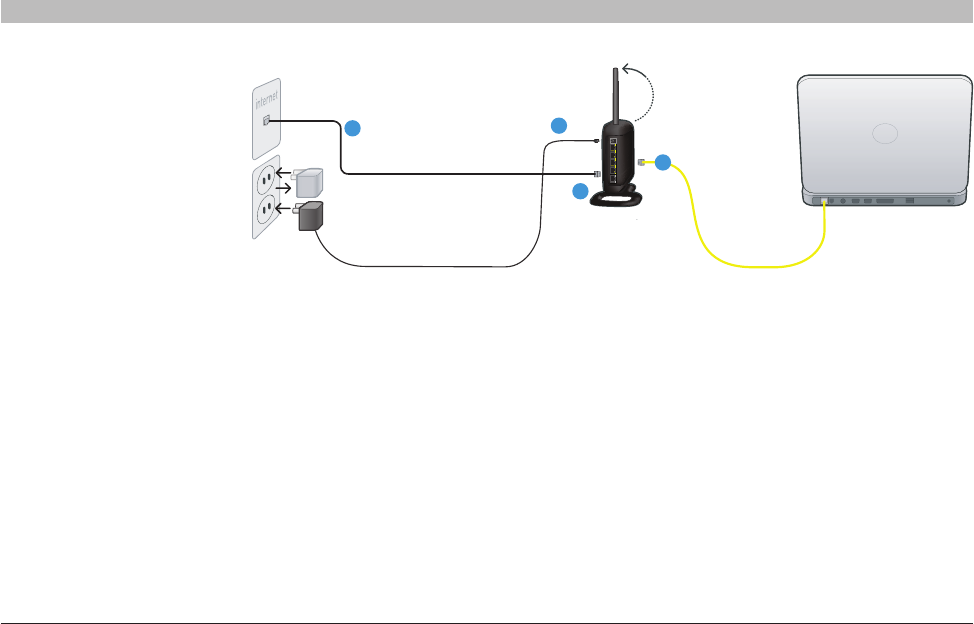
12
G Wireless Modem Router
SECTIONSTable of Contents 123 5678910
CONNECTING AND CONFIGURING YOUR ROUTER
4
1.1 Brand-New Setup
Follow these steps if you are not
replacing an existing modem�
If you are replacing an existing
modem, skip to the next section,
“Replacing an Existing Modem or
Modem Router”�
1. Retrieve the yellow RJ45
cable that was included
with your Router� First,
connect one end to any
yellow port labeled “to
Wired Computers” on the
back of your Router� Then,
connect the other end to the
networking port on the back
of your computer�
2. Retrieve the included gray
RJ11 phone cord� Connect
one end to the gray port
labeled “to ADSL” on the
back of your Router� Then,
connect the other end to
your ADSL connection
(either a wall jack or an
ADSL splitter)�
Note: Some ADSL connections require a
micro filter� Your ADSL provider can tell you if
you need one� Belkin includes a micro filter in
regions known to use them� You may or may
not have received one in your box�
3. Plug your Router’s power
supply into the black port
labeled “Power” on the back
of your Router�
4. Wait 20 seconds for the
Router to start up� Look at
the display on the front of
the Router� Make sure the
“Power” and “LAN (1-4)”
LEDs are lit up in green�
1
3
2
2
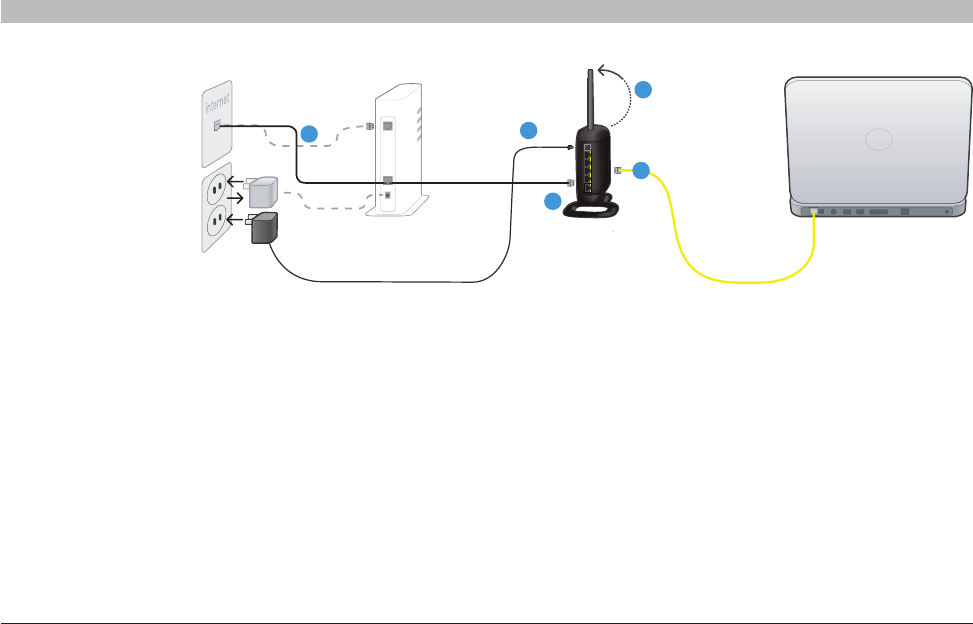
13
G Wireless Modem Router
SECTIONSTable of Contents 123 56789104
CONNECTING AND CONFIGURING YOUR ROUTER
1.2 Replacing an
Existing Modem or
Modem Router
Follow these steps if you
currently have a modem
or a modem router that
you will be replacing with
your new Router�
1. Unpack your new
Router from the box
and place it next
to your computer�
Raise the Router’s
antennas�
2. Locate the cable
that connects your
old modem to your
computer� Unplug
that cable from your
old modem and plug
it into any yellow
port labeled “to
Wired Computers”
on the back of your
new Router�
3. Locate the cable
that connects your
old modem to the
ADSL wall jack�
Unplug it from your
old modem and then
connect it to the
gray port labeled “to
ADSL” on the back
of your Router�
4. Plug your Router’s
power supply into
the black port
labeled “Power”
on the back of
your Router�
5. Wait 20 seconds
for the Router to
start up� Look at
the display on the
front of the Router�
Make sure the
“Power” and “LAN
(1-4)” LEDs are lit up
in green�
2
1
3
4
3
LA
N
ADSL

14
G Wireless Modem Router
SECTIONSTable of Contents 123 56789104
CONNECTING AND CONFIGURING YOUR ROUTER
Note for Windows Users: If the Setup Assistant does not start
up automatically, select your CD-ROM drive from “My Computer”
and double-click on the file named “SetupAssistant” to start the
Setup Assistant�
1. Shut down any programs that are running on your computer
at this time�
Turn off any firewall or Internet-connection-sharing software on
your computer�
3. Insert the CD into your computer� The Setup Assistant will
automatically appear on your computer’s screen within 15
seconds� Click on “Go” to run the Setup Assistant� Follow
the instructions there�
IMPORTANT: Run the Setup Assistant from the computer that is
directly connected to the Router from 1�1 Step 1�
Step 2: Set Up the Router – Run the Setup Assistant Software
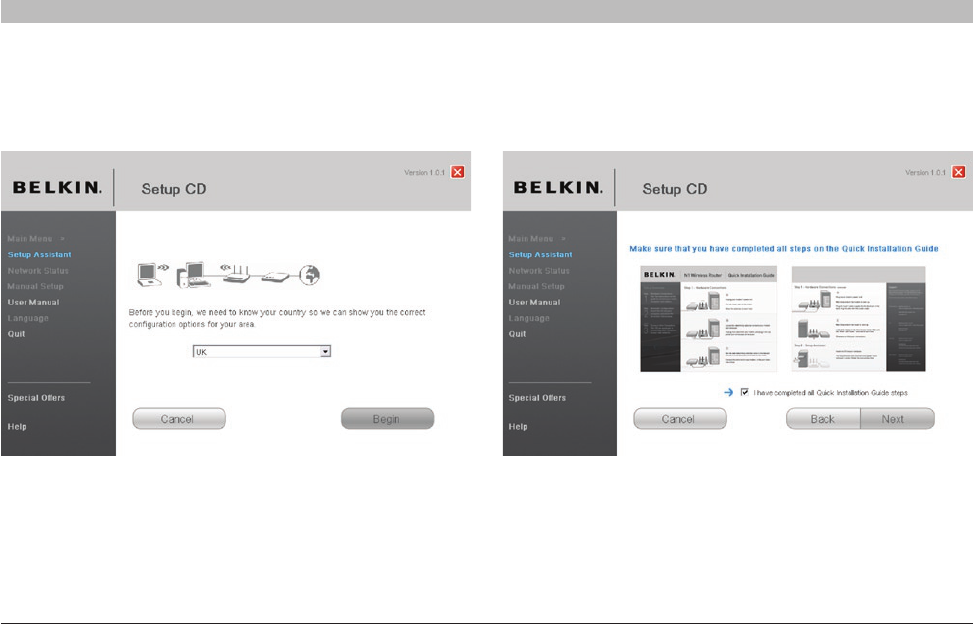
15
G Wireless Modem Router
SECTIONSTable of Contents 123 56789104
CONNECTING AND CONFIGURING YOUR ROUTER
2.2 Confirmation Screen
Verify that you have completed all QIG steps by checking the box to the
right of the arrow� Click “Next” to continue�
2.1 Select Country
Select your country from the drop-down box� Click “Begin” to continue�
Note to US model owner: To comply with US FCC regulation, the country
selection function has been completely removed from all US models. The
above function is for non-US models only.
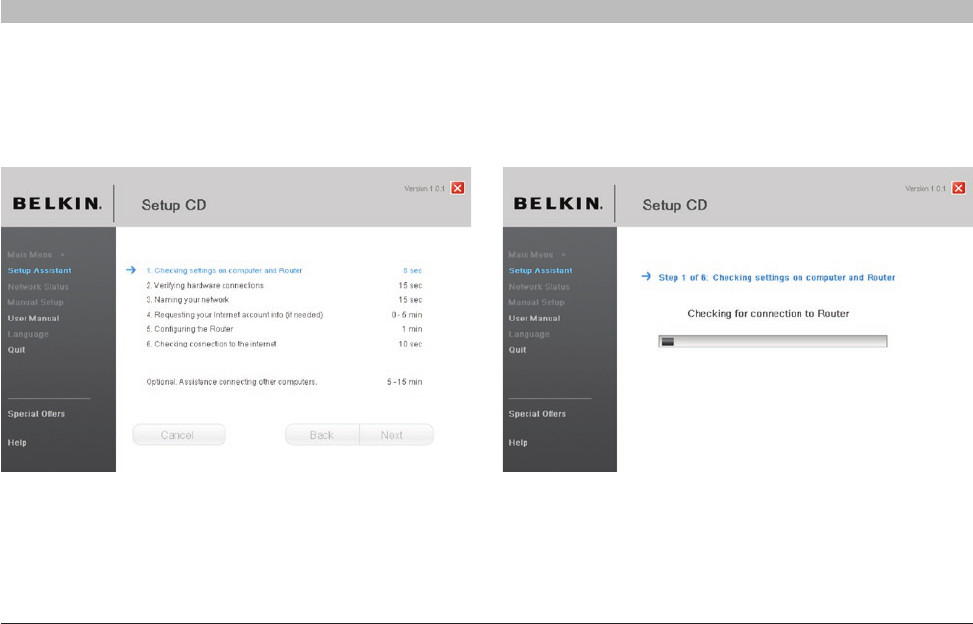
16
G Wireless Modem Router
SECTIONSTable of Contents 123 56789104
CONNECTING AND CONFIGURING YOUR ROUTER
2.4 Checking Settings
The Setup Assistant will now examine your computer’s network settings
and gather information needed to complete the Router’s connection to
the Internet�
2.3 Progress Screen
Setup Assistant will show you a progress screen each time a step in the
setup has been completed�
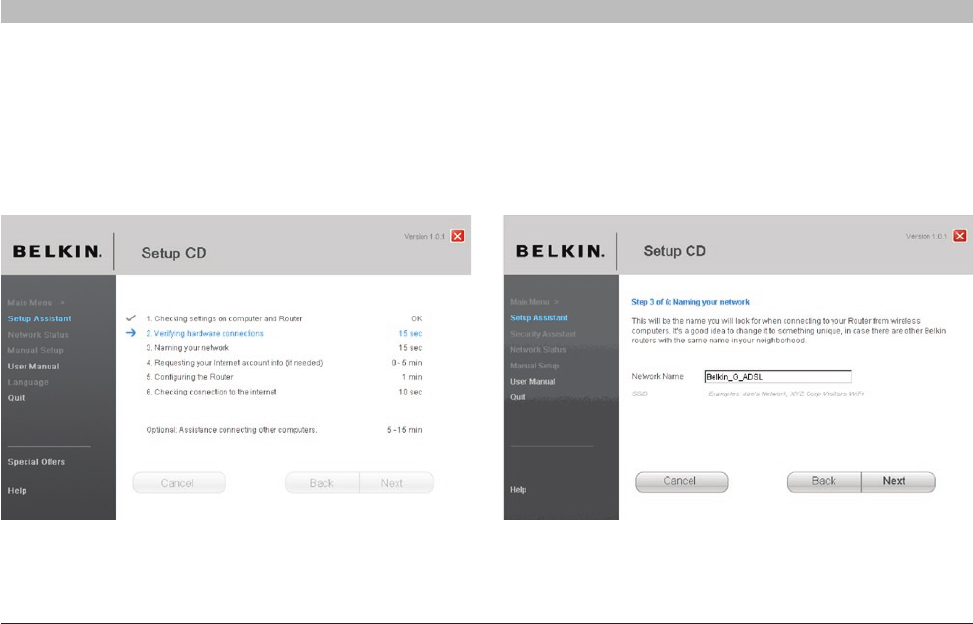
17
G Wireless Modem Router
SECTIONSTable of Contents 123 56789104
CONNECTING AND CONFIGURING YOUR ROUTER
2.6 Naming your Wireless Network
The Setup Assistant will display the default wireless network name or
Service Set Identifier (SSID)� This is the name of your wireless network
to which your computers or devices with wireless network adapters
will connect� You can either use the default or change it to something
unique� Write down this name for future reference� Click “Next”
to continue�
2.5 Verifying Hardware Connections
The Setup Assistant will now verify your hardware connection�
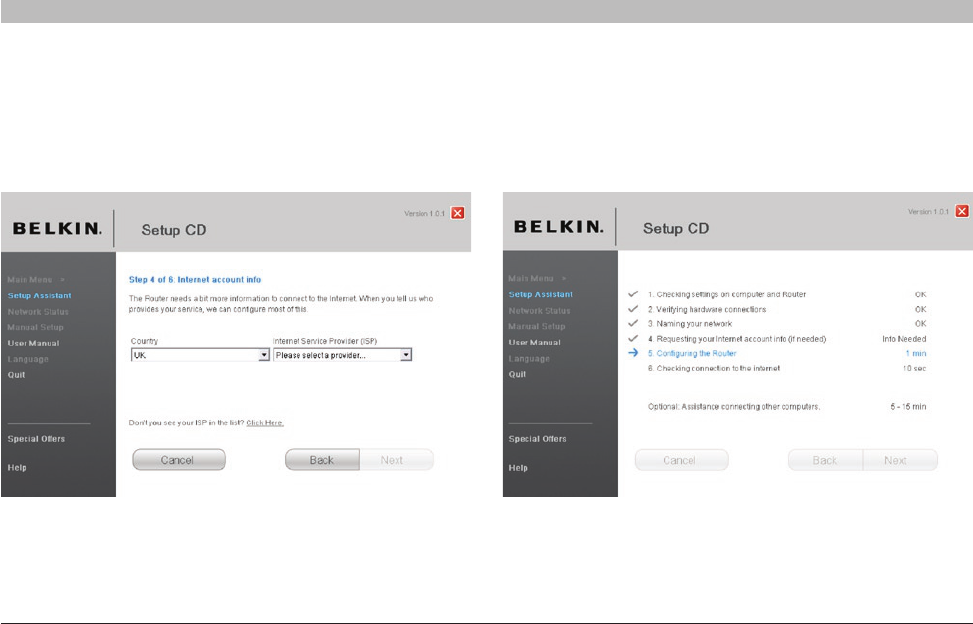
18
G Wireless Modem Router
SECTIONSTable of Contents 123 56789104
CONNECTING AND CONFIGURING YOUR ROUTER
2.8 Configuring the Router
The Setup Assistant will now configure your Router by sending data to
the Router and restarting it� Wait for the on-screen instructions�
Note: Do not disconnect any cable or power off the Router while the
Router is rebooting� Doing so will render your Router inoperable�
2.7 Requesting Internet Account Info (if needed)
If your Internet account requires a login and password, you will be
prompted with a screen similar to the illustration below� Select your
country or ISP from the drop-down boxes�
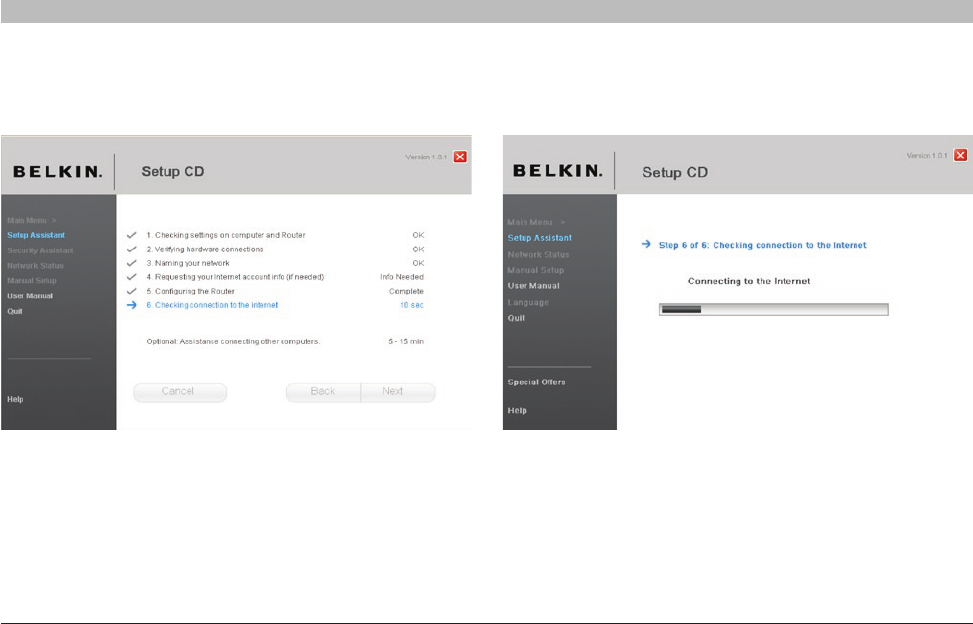
19
G Wireless Modem Router
SECTIONSTable of Contents 123 56789104
CONNECTING AND CONFIGURING YOUR ROUTER
2.9 Checking Internet Connection
We are almost done� The Setup Assistant will now check your connection to the Internet�
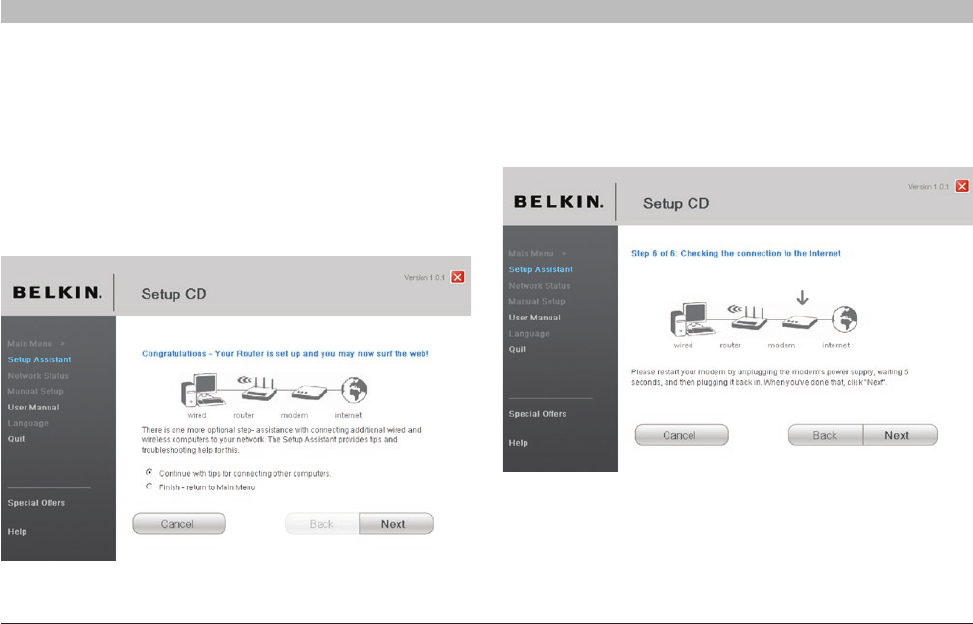
20
G Wireless Modem Router
SECTIONSTable of Contents 123 56789104
CONNECTING AND CONFIGURING YOUR ROUTER
Troubleshooting
If the Setup Assistant is not able to connect to the Internet, you will see
the following screen� Follow the on-screen instructions to go through the
troubleshooting steps�
Congratulations
You have finished installing your new Belkin Router� You will see
the Congratulations screen when your Router can connect to the
Internet� You can begin surfing by opening your browser and going to
any website�
You can use the Setup Assistant to set up your other wired and wireless
computers to connect to the Internet by clicking “Next”� If you decide to
add computers to your Router later, select “Exit the Assistant” and then
click “Next”�
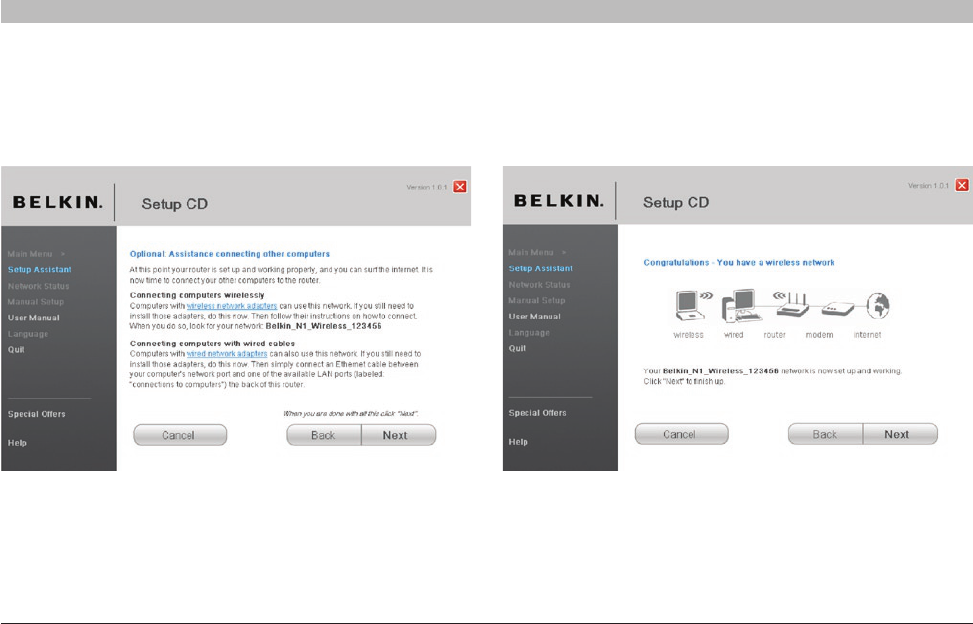
21
G Wireless Modem Router
SECTIONSTable of Contents 123 56789104
CONNECTING AND CONFIGURING YOUR ROUTER
Once you have verified that your other wired and wireless computers are
properly connected, your network is set up and working� You can now
surf the Internet� Click “Next” to take you back to the main menu�
2.10 Optional: Assistance Connecting Other Computers
This optional step will help you to connect additional wired and wireless
computers to your network� Follow the on-screen instructions�
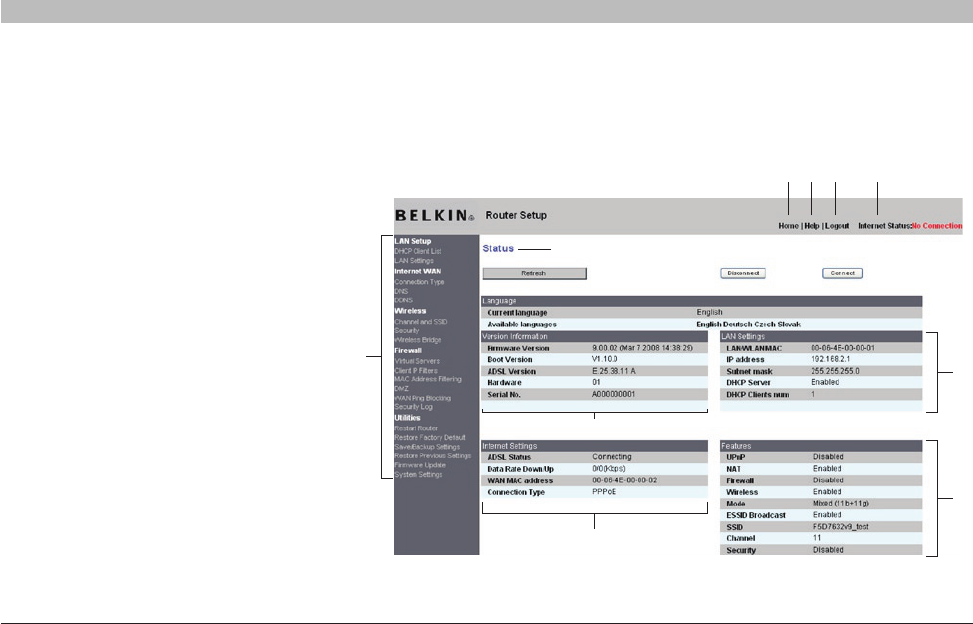
22
G Wireless Modem Router
SECTIONSTable of Contents 1234 678910
MANUALLY CONFIGURING YOUR ROUTER
5
Understanding the Web-Based User Interface
The home page shows you a quick view of the Router’s status and settings� All advanced setup pages can be reached from this page�
Using Web-Based Manager
Once your host PC is properly configured,
start your web browser and type the private
IP address of the Router into the URL field:
“192�168�2�1” and then click “Enter”�
(1)
(2)
(10)
(3) (4) (5)
(6)
(7)
(8)
(9)

23
G Wireless Modem Router
SECTIONSTable of Contents 1234 6789105
MANUALLY CONFIGURING YOUR ROUTER
1. Quick-Navigation Links
You can go directly to any of the Router’s UI pages by clicking directly
on these links� The links are divided into logical categories and grouped
by tabs to make finding a particular setting easier to find� Clicking
on the header of each tab will show you a short description of the
tab’s function�
2. Home Button
The “Home” button is available in every page of the UI� Pressing this
button will take you back to the home page�
3. Help Button
The “Help” button gives you access to the Router’s help pages� Help
is also available on many pages by clicking “more info” next to certain
sections of each page�
4. Login/Logout Button
This button enables you to log in and out of the Router with the press of
one button� When you are logged into the Router, this button will change
to read “Logout”� Logging into the Router will take you to a separate
login page where you will need to enter a password� When you are
logged into the Router, you can make changes to the settings� When you
are finished making changes, you can log out of the Router by clicking
the “Logout” button� For more information about logging into the Router,
see the section called “Logging into the Router”�
5. Internet Status Indicator
This indicator is visible in all pages of the Router, showing the
connection status of the Router� When the indicator says “connection
OK” in GREEN, the Router is connected to the Internet� When the Router
is not connected to the Internet, the indicator will read “no connection”
in RED� The indicator is automatically updated when you make changes
to the settings of the Router�

24
G Wireless Modem Router
SECTIONSTable of Contents 1234 6789105
MANUALLY CONFIGURING YOUR ROUTER
9. Version Info
Shows the firmware version, boot-code version, hardware version, and
serial number of the Router�
10. Page Name
The page you are on can be identified by this name� This manual will
sometimes refer to pages by name� For instance, “LAN > LAN Settings”
refers to the “LAN Settings” page�
6. LAN Settings
Shows you the settings of the Local Area Network (LAN) side of the
Router� Changes can be made to the settings by clicking the “LAN”
“Quick Navigation” link on the left side of the screen�
7. Features
Shows the status of the Router’s NAT, firewall, and wireless features�
Changes can be made to the settings by clicking on any one of the links
or by clicking the “Quick Navigation” links on the left side of the screen�
8. Internet Settings
Shows the settings of the Internet/WAN side of the Router that connects
to the Internet� Changes to any of these settings can be made by
clicking on the “Internet/WAN” “Quick Navigation” link on the left side
of the screen�
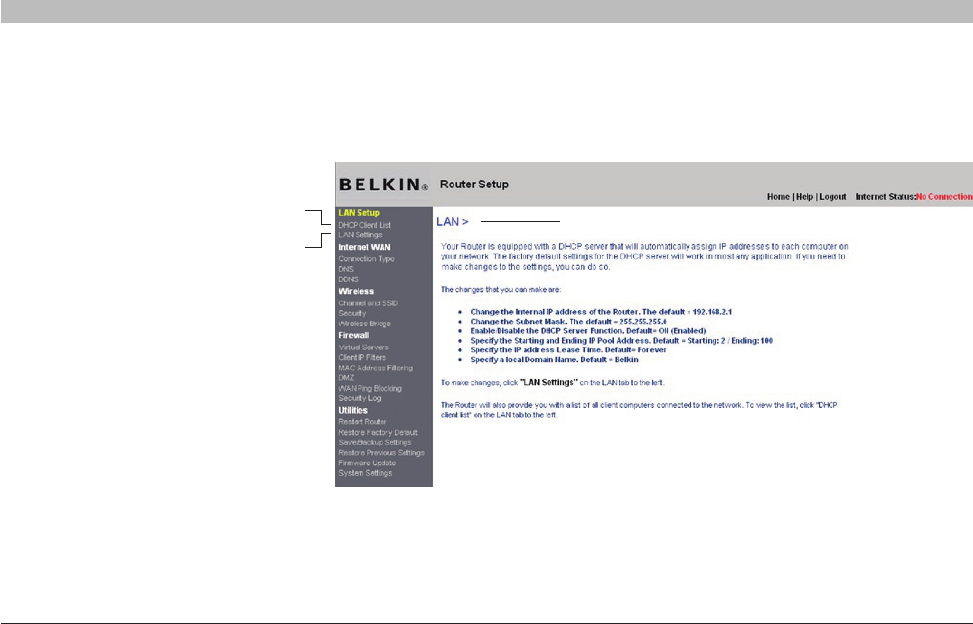
25
G Wireless Modem Router
SECTIONSTable of Contents 1234 6789105
MANUALLY CONFIGURING YOUR ROUTER
Changing LAN Settings
All settings for the internal LAN setup of the Router can be viewed and changed here�
LAN Settings
Clicking on the header of the
LAN tab (A) will take you to the
LAN tab’s header page� A quick
description of the functions
can be found here� To view the
settings or make changes to
any of the LAN settings, click on
“LAN Settings” (B) or to view the
list of connected computers, click
on “DHCP Client List” (C)�
(A)
(B)
(C)

26
G Wireless Modem Router
SECTIONSTable of Contents 1234 6789105
MANUALLY CONFIGURING YOUR ROUTER
IP Address
The “IP address” is the internal IP address of the Router� The default IP
address is “192�168�2�1”� To access the advanced setup interface, type
this IP address into the address bar of your browser� This address can
be changed if needed� To change the IP address, type in the new IP
address and click “Apply Changes”� The IP address you choose should
be a non-routable IP� Examples of a non-routable IP are:
192�168�x�x (where x is anything between 0 and 255)
10�x�x�x (where x is anything between 0 and 255)
Subnet Mask
There is no need to change the subnet mask� This is a unique, advanced
feature of your Belkin Router�
DHCP Server
The DHCP server function makes setting up a network very easy by
assigning IP addresses to each computer on the network automatically�
The default setting is “On”� The DHCP server can be turned OFF if
necessary; however, in order to do so, you must manually set a static
IP address for each computer on your network� To turn off the DHCP
server, select “Off” and click “Apply Changes”�
IP Pool
The range of IP addresses set aside for dynamic assignment to the
computers on your network� If you want to change this number, you can
do so by entering a new starting and ending IP address and clicking on
“Apply Changes”� The starting IP address must be lower in number than
the ending IP address�
Lease Time
The length of time the DHCP server will reserve the IP address for each
computer� We recommend that you leave the lease time set to “Forever”�
The default setting is “Forever”, meaning that any time a computer is
assigned an IP address by the DHCP server, the IP address will not
change for that particular computer� Setting lease times for shorter
intervals such as one day or one hour frees IP addresses after the
specified period of time� This also means that a particular computer’s
IP address may change over time� If you have set any of the other
advanced features of the Router such as DMZ or client IP filters, these
are dependent on the IP address� For this reason, you will not want the
IP address to change�
Local Domain Name
You can set a local domain name (network name) for your network�
There is no need to change this setting unless you have a specific
advanced need to do so� You can name the network anything you want
such as “MY NETWORK”�

27
G Wireless Modem Router
SECTIONSTable of Contents 1234 6789105
MANUALLY CONFIGURING YOUR ROUTER
DHCP Client List
You can view a list of the computers, which are connected to your network� You are able to view the IP address of the computer, the host name (name
of the computer in your network), and the MAC address of the computer’s network interface card (NIC)� Pressing the “Refresh” button will update the
list� If there have been any changes, the list will be updated�
Internet WAN
The “Internet WAN” tab is where you will set up your Router to connect to your Internet Service Provider (ISP)� The Router is capable of connecting
to virtually any ADSL service provider’s system provided you have correctly configured the Router’s settings for your ISP’s connection type� Your
connection settings are provided to you by your ISP�
To configure the Router with the settings that your ISP gave you, click “Connection Type” (1) on the left side of the screen� Select the connection type
you use� If your ISP gave you DNS settings, clicking “DNS” (2) allows you to enter DNS address entries for ISPs that require specific settings� When
you have finished making settings, the “Internet Status” indicator will read “Connected” if your Router is set up properly�
Connection Type
From the “Connection Type” page, you can select one of these five
connection types based on the instructions provided by your ISP:
PPPoE
PPPoA
Dynamic IP (1483 Bridged)
Static IP (IPoA)
Modem Only (Disable Internet Sharing)
Note: If you are not sure which connection type to select, please
contact your ISP�
Select the type of connection you use by clicking the radio button next
to your connection type and then clicking “Next”�

28
G Wireless Modem Router
SECTIONSTable of Contents 1234 6789105
MANUALLY CONFIGURING YOUR ROUTER
Setting your ISP Connection Type to PPPoE or PPPoA
PPPoE (Point-to-Point Protocol over Ethernet) is the standard method of connecting networked devices� It requires a user name and password to
access the network of your ISP for connecting to the Internet� PPPoA (PPP over A™ ) is similar to PPPoE, but is mostly implemented in the UK� Select
PPPoE or PPPoA and click “Next”� Then, enter the information provided by your ISP, and click “Apply Changes” to activate your settings�
6. Encapsulation – Select your encapsulation type (supplied by
your ISP) to specify how to handle multiple protocols at the A™
transport layer� VC-MUX: PPPoA Virtual Circuit Multiplexer (null
encapsulation) allows only one protocol running per virtual circuit
with fewer overheads� LLC: PPPoA Logical Link Control allows
multiple protocols running over one virtual circuit (more overhead)�
7. Dial on Demand – By selecting “Dial on Demand”, your Router
will automatically connect to the Internet when a user opens up a
web browser�
8. Idle Time (Minutes) – Enter the maximum idle time for the Internet
connection� After this time has been exceeded, the connection will
be terminated�
9. MTU – The MTU setting should never be changed unless your
ISP requires a specific MTU setting� Making changes to the MTU
can cause problems with your Internet connection, including
disconnection from the Internet, slow Internet access, and
problems with Internet applications working properly�
1. User Name – Enter the user name� (Assigned by your ISP)�
2. Password – Enter your password� (Assigned by your ISP)�
3. Retype Password – Confirm the password� (Assigned by your ISP)�
4. IP Assigned by ISP – Leave “Yes” if your ISP automatically assigns
an IP address� If your ISP assigned a fixed IP address, select “No”
and enter assigned values�
5. VPI/VCI – Enter your Virtual Path Identifier (VPI) and Virtual Circuit
Identifier (VCI) parameter here� (Assigned by your ISP)�

29
G Wireless Modem Router
SECTIONSTable of Contents 1234 6789105
MANUALLY CONFIGURING YOUR ROUTER
Setting your Connection Type to Dynamic IP (1483 Bridged)
This connection method bridges your network and ISP’s network
together� The Router will obtain an IP address automatically from your
ISP’s DHCP server�
1. IP Assigned by ISP – Leave “Yes” if your ISP automatically assigns
an IP address� If your ISP assigned a fixed IP address, select “No”
and enter assigned values�
2. VPI/VCI – Enter your VPI and VCI parameter here� These identifiers
are assigned by your ISP�
3. Encapsulation – Select LLC or VC MUX your ISP uses�
Setting your ISP Connection Type to Static IP (IPoA)
This connection type is also called “Classical IP over A™ ” or “CLIP”,
which your ISP provides a fixed IP for your Router to connect to
the Internet�
1. IP Address – Enter an IP address assigned by your ISP for the
Router WAN interface�
2. Subnet Mask – Enter a subnet mask assigned by your ISP�
3. Default Gateway – Enter a default gateway IP address� If the
Router cannot find the destination address within its local network,
it will forward the packets to the default gateway assigned by
your ISP�
4. VPI/VCI – Enter your VPI and VCI parameter here� These identifiers
are assigned by your ISP�
5. Encapsulation – Select LLC or VC MUX (assigned by your ISP)�
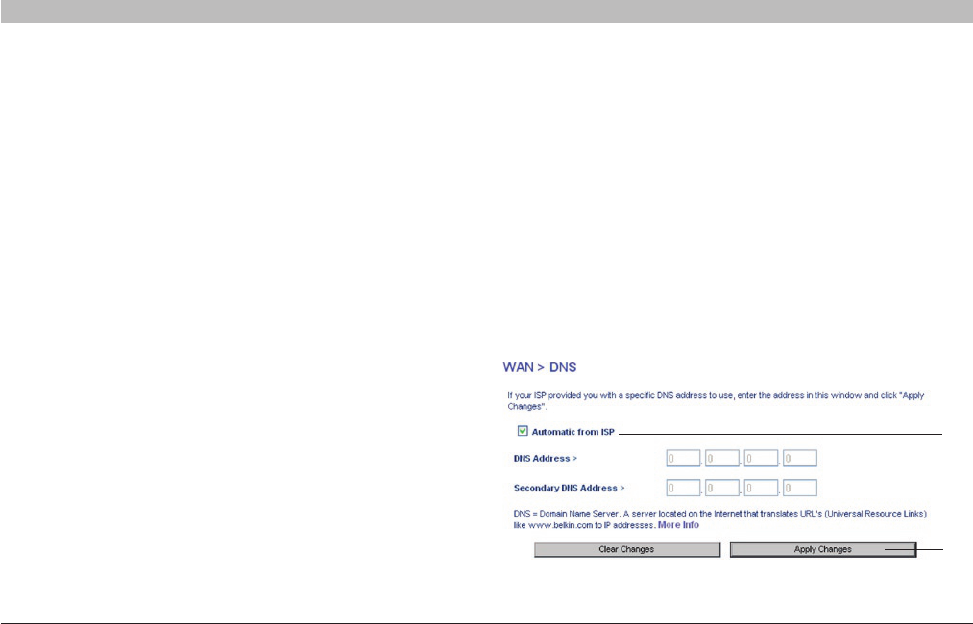
30
G Wireless Modem Router
SECTIONSTable of Contents 1234 6789105
MANUALLY CONFIGURING YOUR ROUTER
Setting your Connection Type to Modem Only (Disable
Internet Sharing)
In this mode, the Router simply acts as a bridge passing packets across
the DSL port� It requires additional software to be installed on your
computers in order to access the Internet�
1. VPI/VCI – Enter your VPI and VCI parameter here� (Assigned by
your ISP)�
2. Encapsulation – Select LLC or VC MUX� (Assigned by your ISP)�
DNS (Domain Name Server) Settings
A “Domain Name Server” is a server located on the Internet that
translates Universal Resource Links (URLs) like “www�belkin�com” to IP
addresses� Many ISPs do not require you to enter this information into
the Router� The “Automatic from ISP” box (1) should be checked if your
ISP did not give you a specific DNS address� If you are using a static IP
connection type, then you may need to enter a specific DNS address
and secondary DNS address for your connection to work properly� If
your connection type is dynamic or PPPoE, it is likely that you do not
have to enter a DNS address�
Leave the “Automatic from ISP” box checked� To enter the DNS address
settings, uncheck the “Automatic from ISP” box and enter your DNS
entries in the spaces provided� Click “Apply Changes” (2) to save
the settings�
(1)
(2)
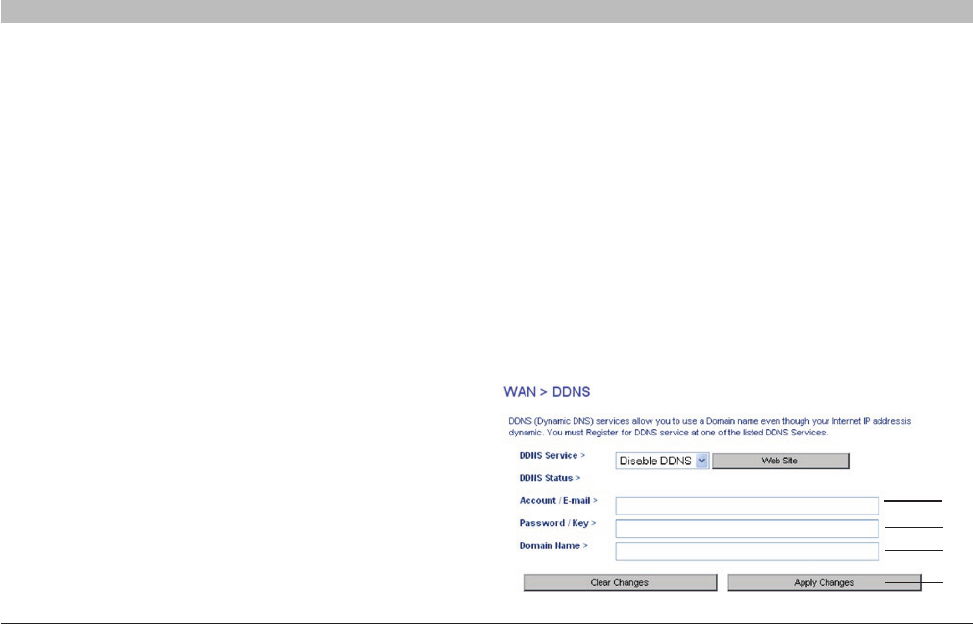
31
G Wireless Modem Router
SECTIONSTable of Contents 1234 6789105
MANUALLY CONFIGURING YOUR ROUTER
Using DDNS (Dynamic DNS)
The DDNS service allows you to alias a dynamic IP address to a static
host name in any of the many domains DynDNS�org offers, allowing your
network computers to be more easily accessed from various locations
on the Internet� DynDNS�org provides this service, for up to five host
names, free to the Internet community� TZO�com is another alternative
to DynDNS�org� DDNS service is ideal for a home website, file server, or
to make it easy to access your home PC and stored files while you’re at
work� Using the service can ensure that your host name always points to
your IP address, no matter how often your ISP changes it� When your IP
address changes, your friends and associates can always locate you by
visiting yourname�dyndns�org instead! To register free for your Dynamic
DNS host name, please visit http://www�dyndns�org�
Setting up the Router’s Dynamic DNS Update Client
You must register with DynDNS�org’s free update service before using
this feature� Once you have your registration, follow the directions below�
1. Enter your DynDNS�org user name in the “Account / E-mail”
field (1)�
2. Enter your DynDNS�org password in the “Password / Key” field (2)�
3. Enter the DynDNS�org domain name you set up with DynDNS�org
in the “Domain Name” field (3)�
4. Click “Apply Changes” to update your IP address�
Whenever your IP address assigned by your ISP changes, the
Router will automatically update DynDNS�org’s servers with your
new IP address� You can also do this manually by clicking the “Apply
Changes” button (4)�
(1)
(2)
(4)
(3)

32
G Wireless Modem Router
SECTIONSTable of Contents 1234 6789105
MANUALLY CONFIGURING YOUR ROUTER
Wireless
The “Wireless” tab lets you make changes to the wireless network settings� From this tab, you can make changes to the wireless network name
(SSID), operating channel, and encryption security settings�
1. Changing the Wireless Network Name (SSID)
To identify your wireless network, a name called the SSID (Service Set
Identifier) is used� You can change this to anything you want to or you
can leave it unchanged� If there are other wireless networks operating in
your area, you will want to make sure that your SSID is unique (does not
match that of another wireless network in the area)� To change the SSID,
type in the SSID that you want to use in the SSID field and click “Apply
Changes”� The change is immediate� If you make a change to the SSID,
your wireless-equipped computers may also need to be reconfigured to
connect to your new network name� Refer to the documentation of your
wireless network adapter for information on making this change�
2. Using the ESSID Broadcast Feature
For security purposes, you can choose not to broadcast your network’s
SSID� Doing so will keep your network name hidden from computers
that are scanning for the presence of wireless networks� To turn off
the broadcast of the SSID, select “DISABLE” and then click “Apply
Changes”� The change is immediate� Each computer now needs to be
set to connect to your specific SSID; an SSID of “ANY” will no longer be
accepted� Refer to the documentation of your wireless network adapter
for information on making this change�
Note: This advanced feature should be employed by advanced users only�
Channel and SSID

33
G Wireless Modem Router
SECTIONSTable of Contents 1234 6789105
MANUALLY CONFIGURING YOUR ROUTER
4. Changing the Wireless Channel
There are a number of operating channels from which to choose� In the
United States, there are 11 channels� In the United Kingdom and most
of Europe, there are 13 channels� In a small number of other countries,
there are other channel requirements� Your Router is configured to
operate on the proper channels in which the country you reside� The
default is “Auto”� The channel can be changed if needed� If there are
other wireless networks operating in your area, your network should
be set to operate on a channel that is different than the other wireless
networks� For best performance, use a channel that is at least five
channels away from the other wireless network� For instance, if another
network is operating on channel 11, then set your network to channel 6
or below� To change the channel, select the channel from the drop-down
list� Click “Apply Changes”� The change is immediate�
3. Using the Wireless Mode Switch
Your Router can operate in three different wireless modes: “Mixed
(11b+11g)”, “11g Only”, and “11b Only”� The different modes are
explained below�
Mixed (11b+11g) Mode
In this mode, the Router is compatible with 802�11b and 802�11g wireless
clients simultaneously� This is the factory default mode and ensures
successful operation with all devices compatible with Wi-Fi® � If you have
a mix of 802�11b and 802�11g clients in your network, we recommend
that you keep the default setting� This setting should only be changed if
you have a specific reason to do so�
11g-Only Mode
802�11g-Only mode works with 802�11g clients only� This mode
is recommended only if you want to prevent 802�11b clients from
accessing your network� To switch modes, select the desired mode from
the “Wireless Mode” drop-down box� Then, click “Apply Changes”�
11b-Only Mode
We recommend you DO NOT use this mode unless you have a very
specific reason to do so� This mode exists only to solve unique
problems that may occur with some 802�11b client adapters and is NOT
necessary for interoperability of 802�11g and 802�11b standards�

34
G Wireless Modem Router
SECTIONSTable of Contents 1234 6789105
MANUALLY CONFIGURING YOUR ROUTER
Encryption/Security
Name 64-Bit Wired
Equivalent
Privacy
128-Bit Wired
Equivalent
Privacy
Wi-Fi Protected
Access-TKIP Wi-Fi Protected
Access 2
Acronym 64-bit WEP 128-bit WEP WPA-TKIP/AES
(or just WPA) WPA2-AES (or
just WPA2)
Security Good Better Best Best
Features Static keys Static keys
Dynamic key
encryption
and mutual
authentication
Dynamic key
encryption
and mutual
authentication
Encryption
keys based on
RC4 algorithm
(typically
40-bit keys)
More secure
than 64-bit
WEP using a
key length of
104 bits plus
24 additional
bits of system-
generated data
TKIP (Temporal
Key Integrity
Protocol) added
so that keys
are rotated and
encryption is
strengthened
AES (Advanced
Encryption
Standard) does
not cause any
throughput loss
Securing your Wi-Fi Network
Here are a few different ways you can
maximize the security of your wireless network
and protect your data from prying eyes and
ears� This section is intended for the home,
home-office, and small-office user� At the time
of this User Manual’s publication, there are
four encryption methods available�

35
G Wireless Modem Router
SECTIONSTable of Contents 1234 6789105
MANUALLY CONFIGURING YOUR ROUTER
Wired Equivalent Privacy (WEP)
WEP is a common protocol that adds security to all wireless products that are compliant with Wi-Fi� WEP was designed to give wireless networks the
equivalent level of privacy protection as a comparable wired network�
64-Bit WEP
64-bit WEP was first introduced with 64-bit encryption, which includes
a key length of 40 bits plus 24 additional bits of system-generated data
(64 bits total)� Some hardware manufacturers refer to 64-bit as 40-bit
encryption� Shortly after the technology was introduced, researchers
found that 64-bit encryption was too easy to decode�
128-Bit WEP
As a result of 64-bit WEP’s potential security weaknesses, a more
secure method of 128-bit encryption was developed� 128-bit encryption
includes a key length of 104 bits plus 24 additional bits of system-
generated data (128 bits total)� Some hardware manufacturers refer to
128-bit as 104-bit encryption� Most of the new wireless equipment in the
market today supports both 64-bit and 128-bit WEP encryption, but you
might have older equipment that only supports 64-bit WEP� All Belkin
wireless products will support both 64-bit and 128-bit WEP�
Encryption Keys
After selecting either the “64-bit” or “128-bit WEP” encryption mode,
it is critical that you generate an encryption key� If the encryption key
is not consistent throughout the entire wireless network, your wireless
networking devices will be unable to communicate with one another
on your network and you will not be able to successfully communicate
within your network� You can enter your key by typing in the hex key
manually, or you can type in a passphrase in the “Passphrase” field and
click “Generate” to create a key� A hex (hexadecimal) key is a mixture
of numbers and letters from A–F and 0–9� For 64-bit WEP, you need to
enter 10 hex keys� For 128-bit WEP, you need to enter 26 hex keys�
For instance:
AF 0F 4B C3 D4 = 64-bit WEP key
C3 03 0F AF 0F 4B B2 C3 D4 4B C3 D4 E7 = 128-bit WEP key
The WEP passphrase is NOT the same as a WEP key� Your wireless card
uses this passphrase to generate your WEP keys, but different hardware
manufacturers might have different methods for generating the keys� If
you have equipment from multiple vendors in your network, you can use
the hex WEP key from your Router or access point and enter it manually
into the hex WEP key table in your wireless card’s configuration screen�

36
G Wireless Modem Router
SECTIONSTable of Contents 1234 6789105
MANUALLY CONFIGURING YOUR ROUTER
Wi-Fi Protected Access (WPA)
WPA is a new Wi-Fi standard that was designed to improve upon the
security features of WEP� To use WPA security, the drivers and software
of your wireless equipment must be upgraded to support WPA� These
updates will be found on the wireless vendors’ websites� There are two
types of WPA security: WPA-PSK (no server) and WPA (with 802�1x
radius server)�
WPA-PSK (no server)
This method uses what is known as a “pre-shared key” as the
network key� A network key is basically a password that is between
eight and 63 characters long� It can be a combination of letters,
numbers, or characters� Each client uses the same network key to
access the network� Typically, this is the mode that will be used in a
home environment�
WPA (with 802.1x radius server)
With this system, a radius server distributes the network key to the
clients automatically� This is typically found in a business environment�
WPA2
The Router features WPA2, which is the second generation of the
WPA-based 802�11i standard� It offers a higher level of wireless security
by combining advanced network authentication and stronger AES
encryption methods�
WPA2 Requirements
IMPORTANT: In order to use WPA2 security, all your computers and
wireless client adapters must be upgraded with patches, drivers,
and client utility software that support WPA2� At the time of this
User Manual’s publication, a couple security patches are available,
for free download, from Microsoft® � These patches work only with
the Windows XP operating system� Other operating systems are not
supported at this time�

37
G Wireless Modem Router
SECTIONSTable of Contents 1234 6789105
MANUALLY CONFIGURING YOUR ROUTER
For a Windows XP computer that does not have Service Pack 2 (SP2),
a file from Microsoft called “Windows XP Support Patch for Wireless
Protected Access (KB 826942)” is available for free download at http://
www�microsoft�com/downloads/details�aspx?displaylang=en&familyid=0
09D8425-CE2B-47A4-ABEC-274845DC9E91�
For Windows XP computers with SP2, Microsoft has released a free
download to update the wireless client components to support WPA2
(KB893357)� The update can be downloaded from: http://www�microsoft�
com/downloads/details�aspx?FamilyID=662bb74d-e7c1-48d6-95ee-
1459234f4483&DisplayLang=en�
IMPORTANT: You also need to ensure that all your wireless client
cards and adapters support WPA2, and that you have downloaded
and installed the latest driver� Most of the Belkin wireless cards
have updated drivers available for download from the Belkin support
site: www�belkin�com/networking� For a list of Belkin wireless
products that support WPA/WPA2, please visit our website at
www�belkin�com/networking�
Sharing the Same Network Keys
Most Wi-Fi products ship with security turned off� So, once you have
your network working, you need to activate WEP or WPA and make sure
your wireless networking devices are sharing the same network key�
Using a Hexadecimal Key
A hexadecimal key is a mixture of numbers and letters from A–F
and 0–9� 64-bit keys are five 2-digit numbers� 128-bit keys are 13
2-digit numbers�
For instance:
AF 0F 4B C3 D4 = 64-bit key
C3 03 0F AF 0F 4B B2 C3 D4 4B C3 D4 E7 = 128-bit key
In the boxes below, make up your key by writing in two characters
between A–F and 0–9 in each box� You will use this key to program the
encryption settings on your Router and your wireless computers�
Note to Mac users: Original Apple® AirPort® products support 64-bit
encryption only� Apple AirPort 2 products can support 64-bit or 128-bit
encryption� Please check your product to see which version you are
using� If you cannot configure your network with 128-bit encryption, try
64-bit encryption�

38
G Wireless Modem Router
SECTIONSTable of Contents 1234 6789105
MANUALLY CONFIGURING YOUR ROUTER
Changing the Wireless Security Settings
Your Router is equipped with WPA/WPA2, the latest wireless security
standard� It also supports the legacy security standard, WEP� By
default, wireless security is disabled� To enable security, you must first
determine which standard you want to use� To access the security
settings, click “Security” on the “Wireless” tab�
WEP Setup
1. Select “WEP” from the drop-down menu�
2. Select “WEP Mode” of 64-bit or 128-bit�
3. After selecting your WEP mode, you can enter your key by typing in
the hex key manually�
A hex (hexadecimal) key is a mixture of numbers and letters from A–F
and 0–9� For 64-bit WEP, you need to enter 10 hex keys� For 128-bit
WEP, you need to enter 26 hex keys�
For instance:
AF 0F 4B C3 D4 = 64-bit key
C3 03 0F AF 0F 4B B2 C3 D4 4B C3 D4 E7 = 128-bit key
4. Click “Apply Changes” to finish� Encryption in the Router is now
set� Each of your computers on your wireless network will now
need to be configured with the same security settings�
WARNING: If you are configuring the Wireless Router from a computer
with a wireless client, you will need to ensure that security is turned
ON for this wireless client� If this is not done, you will lose your
wireless connection�

39
G Wireless Modem Router
SECTIONSTable of Contents 1234 6789105
MANUALLY CONFIGURING YOUR ROUTER
Setting WPA/WPA2-PSK (no server)
1. From the “Allowed Client Type” drop-down menu, select
“WPA/WPA2”�
2. For “Authentication”, select “Pre-shared Key” for typical home/
SOHO use� This setting will have to be identical on the clients that
you set up�
3. Enter your pre-shared key� This can be from eight to 63 characters
and can be letters, numbers, or symbols� This same key must be
used on all of the clients that you set up� For example, your pre-
shared key might be something like: “Smith family network key”�
4. Click “Apply Changes” to finish� You must now set all clients to
match these settings�
WPA Setup
Note: To use WPA security, all your clients must be upgraded to
drivers and software that support it� At the time of this User Manual’s
publication, a security patch download is available free from Microsoft�
This patch works only with the Windows XP operating system� You also
need to download the latest driver for your Belkin Wireless G Desktop
or Notebook Card from the Belkin support site� Other operating systems
are not supported at this time� Microsoft’s patch only supports devices
with WPA-enabled drivers such as Belkin 802�11g products�
There are two types of WPA security: WPA-PSK (no server) and WPA
(with radius server)� WPA-PSK (no server) uses a so-called pre-shared
key (PSK) as the security key� A pre-shared key is a password that is
between eight and 63 characters long� It can be a combination of letters,
numbers, and other characters� Each client uses the same key to access
the network� Typically, this mode will be used in a home environment�
WPA (with radius server) is a configuration wherein a radius server
distributes the keys to the clients automatically� This is typically used
in a business environment� WPA2 is the second generation of WPA,
offering a more advanced encryption technique over WPA�

40
G Wireless Modem Router
SECTIONSTable of Contents 1234 6789105
MANUALLY CONFIGURING YOUR ROUTER
Wireless Range Extension and Bridging
What is a Wireless Bridge?
A wireless bridge is actually an operation “mode” you can use to extend
the range of your wireless network, or add an extension of your network
in another area of your office or home without running cables�
Note: We can make no guarantees that this feature will interoperate with
hardware from other wireless manufacturers�
Note: Please make sure to download the latest firmware version for the
Router for optimal performance at: http://web�belkin�com/support�
Adding Another Network Segment Wirelessly
Connecting a network switch or hub to the Router’s RJ45 jack will allow
a number of computers connected to the switch access to the rest of
the network�
Setting up a Bridge Between your Router and a Secondary
Access Point
Bridging your Belkin Router to a secondary access point requires that
you access the Router’s Advanced Setup Utility and enter the MAC
address of the access point in the appropriate area� There are also a few
other requirements�
PLEASE BE SURE TO FOLLOW THE STEPS BELOW CAREFULLY�
1. Set your access point to the same channel as the Router� For more
information on changing channels, see the “Wireless - Channel and
SSID” section of this User Manual�
2. Find the access point’s MAC address on the bottom of the access
point� There are two MAC addresses on the bottom label� You will
need the MAC address named “WLAN MAC Address”� The MAC
address starts with “0030BD” and is followed by six other numbers
or letters (i�e�, 0030BD-XXXXXX)� Write the MAC address below�
Go to the next step�
3. Place your secondary access point within range of your Router
and near the area where you want to extend the range or add the
network segment� Typically, indoor range should be between 100
and 200 feet�
4. Connect power to your access point� Make sure the access point is
on and proceed to the next step�
5. From a computer already connected to your Router, access the
Advanced Setup Utility by opening your browser� In the address
bar, type in “192�168�2�1”� Do not type in “www” or “http://” before
the number� Note: If you have changed your Router’s IP address,
use that IP address�
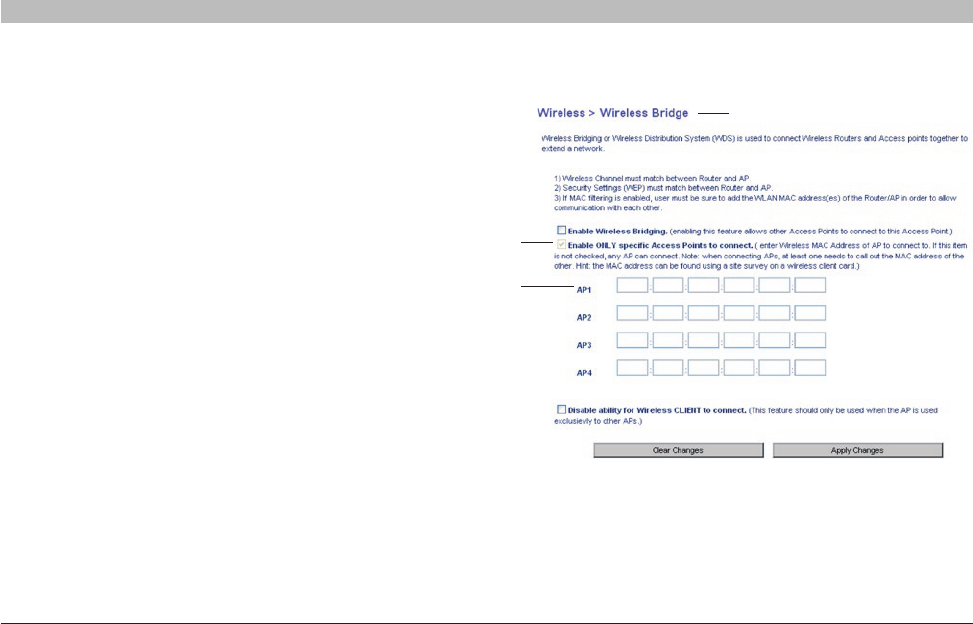
41
G Wireless Modem Router
SECTIONSTable of Contents 1234 6789105
MANUALLY CONFIGURING YOUR ROUTER
6. You will see the Router’s user interface in the browser window�
Click “Wireless Bridge” (2) on the left-hand side of the screen� You
will see the following screen�
7. Check the box that says, “Enable ONLY specific Access Points
to connect” (1)�
8. In the field named “AP1” (3), type in the MAC address of your
secondary access point� When you have typed in the address,
click “Apply Changes”�
9. Bridging is now set up�
Note: It may take up to a minute for the bridged connection to properly
establish itself� In some cases, it may be necessary to restart the access
point and the Router to initiate the bridge�
(1)
(3)
(2)

42
G Wireless Modem Router
SECTIONSTable of Contents 1234 6789105
MANUALLY CONFIGURING YOUR ROUTER
Firewall
Your Router is equipped with a firewall that will protect your network
from a wide array of common hacker attacks including:
• IP Spoofing
• Land Attack
• Ping of Death (PoD)
• Denial of Service (DoS)
• IP with zero length
• Smurf Attack
• TCP Null Scan
• SYN flood
• UDP flooding
• Tear Drop Attack
• ICMP defect
• RIP defect
• Fragment flooding
The firewall also masks common ports that are frequently used to attack
networks� These ports appear to be “Stealth”, meaning that essentially
they do not exist to a would-be hacker� You can turn the firewall function
off if needed; however, it is recommended that you leave the firewall
enabled� Disabling the firewall protection will not leave your network
completely vulnerable to hacker attacks, but it is recommended that you
leave the firewall enabled�
Virtual Servers
Virtual servers allow you to route external (Internet) calls for services
such as a web server (port 80), FTP server (Port 21), or other
applications, through your Router to your internal network� Since your
internal computers are protected by a firewall, machines from the
Internet cannot get to them because they cannot be “seen”� If you need
to configure the virtual server function for a specific application, you will
need to contact the application vendor to find out which port settings
you need� You can manually input this port information into the Router�
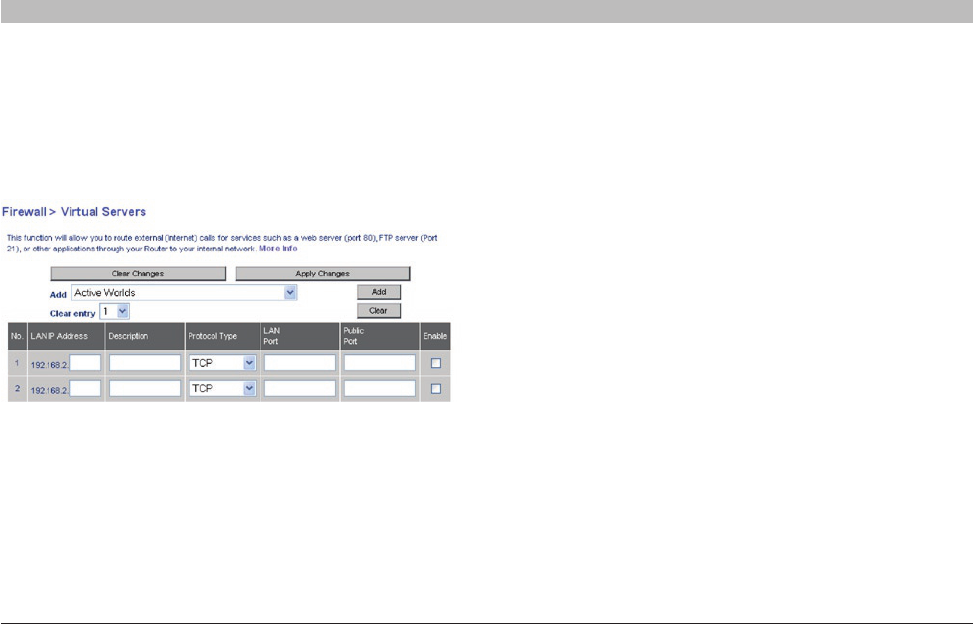
43
G Wireless Modem Router
SECTIONSTable of Contents 1234 6789105
MANUALLY CONFIGURING YOUR ROUTER
Manually Entering Settings into the Virtual Server
To manually enter settings, enter the IP address in the space provided
for the internal (server) machine, the port(s) required to pass, the port
type (TCP or UDP), and click “Apply Changes”� Each inbound port entry
has two fields with five characters maximum per field that allows a start
and end port range (e�g�, [xxxxx]-[xxxxx])� For each entry, you can enter
a single port value by filling in the two fields with the same value (e�g�,
[7500]-[7500]) or a wide range of ports (e�g�, [7500]-[9000])� If you need
multiple single-port values or a mixture of ranges and a single value,
you must use multiple entries up to the maximum of 20 entries (e�g�, 1�
[7500]-[7500], 2� [8023]-[8023], 3� [9000]-[9000])� You can only pass one
port per internal IP address� Opening ports in your firewall can pose
a security risk� You can enable and disable settings very quickly� It is
recommended that you disable the settings when you are not using a
specific application�
Choosing an Application
Select your application from the drop-down list� Click “Add”� The
settings will be transferred to the next available space in the screen�
Click “Apply Changes” to save the setting for that application� To remove
an application, select the number of the row that you want to remove,
then click “Clear”�
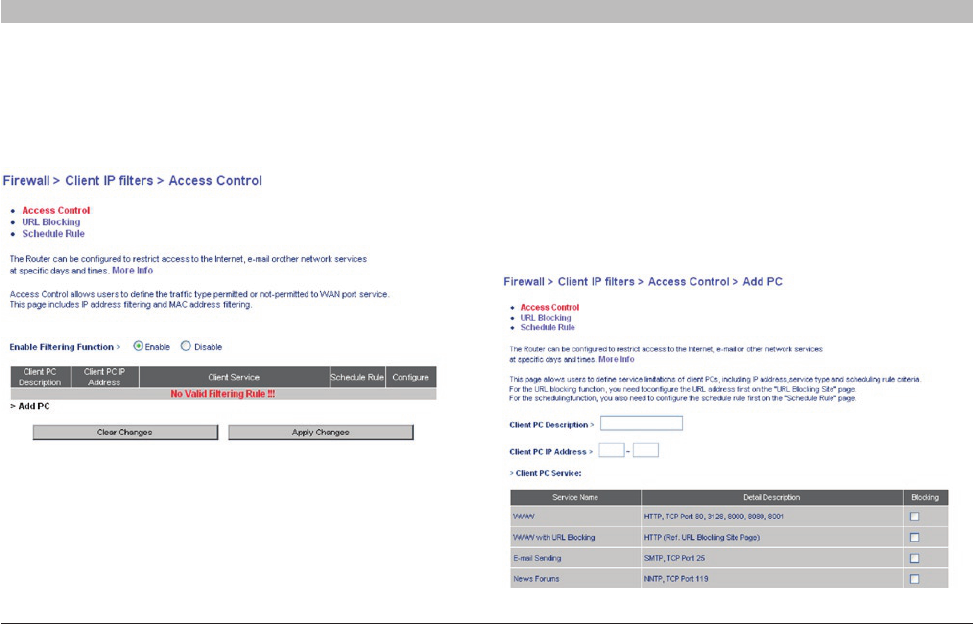
44
G Wireless Modem Router
SECTIONSTable of Contents 1234 6789105
MANUALLY CONFIGURING YOUR ROUTER
Client IP Filters
The Router can be configured to restrict access to the Internet, email, or
other network services at specific days and times� Restriction can be set
for a single computer, a range of computers, or multiple computers�
Access Control
Access control allows users to define the outgoing traffic permitted or
denied access through the WAN interface� The default is to permit all
outgoing traffic� To configure restrictive access to your computers, do
the following:
1. Click “Add PC” on the “Access Control” screen�
2. Define the appropriate settings for client PC services (as shown on
the following screen)�
3. Click “OK” and then click “Apply Changes” to save your settings�

45
G Wireless Modem Router
SECTIONSTable of Contents 1234 6789105
MANUALLY CONFIGURING YOUR ROUTER
Schedule Rule
You may filter Internet access for local clients based on rules� Each
access control rule may be activated at a scheduled time� Define the
schedule on the “Schedule Rule”, and apply the rule on the “Access
Control” page�
Follow these steps to add a schedule:
1. Click “Add Schedule Rule”�
2. You will see the following screen�
3. To configure the schedule rule, specify the name, comment, start
time, and end time that you want to filter on your network�
4. Click “OK” and then “Apply Changes” to save your settings�
5. To complete this configuration, you will need to create or modify
an access rule in the “Client IP filters” section� This activates the
schedule for use in the “Access Control” page�
URL Blocking
To configure the URL-blocking feature, specify the websites (www�
somesite�com) and or keywords you want to filter on your network� Click
“Apply Changes” to activate the change� To complete this configuration,
you will need to create or modify an access rule in the “Client IP filters”
section� To modify an existing rule, click the “Edit” option next to the
rule you want to modify� To create a new rule, click on the “Add PC”
option� From the “Access Control > Add PC” section, check the option
for “WWW with URL Blocking” in the “Client PC Service” table to filter
out the websites and keywords specified�
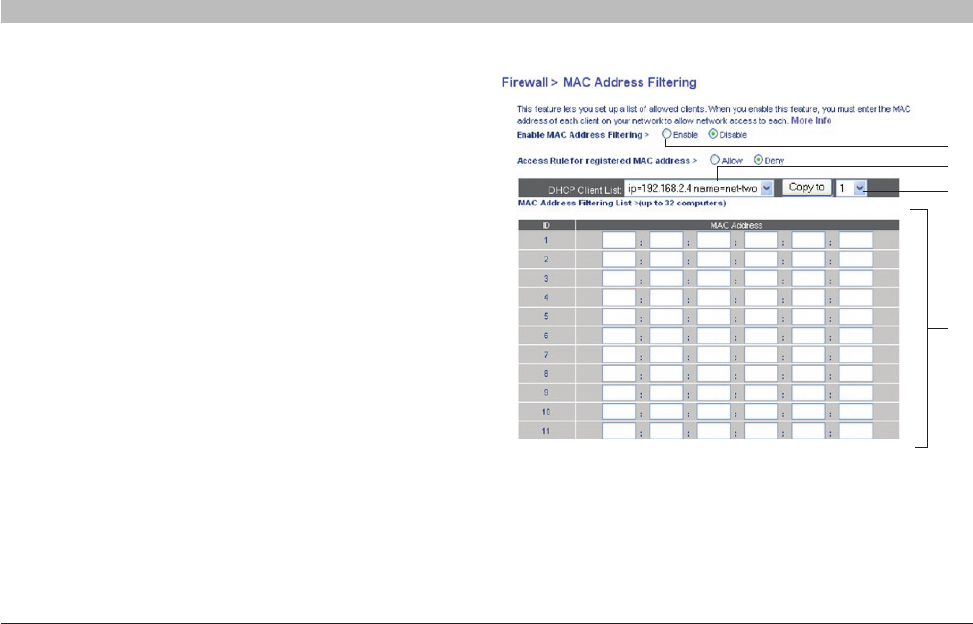
46
G Wireless Modem Router
SECTIONSTable of Contents 1234 6789105
MANUALLY CONFIGURING YOUR ROUTER
(1)
(2)
(3)
(4)
Setting MAC-Address Filtering
The MAC-address filter is a powerful security feature that allows you
to specify which computers are allowed on the network� Any computer
attempting to access the network that is not specified in the filter list
will be denied access� When you enable this feature, you must enter
the MAC address of each client (computer) on your network to allow
network access to each� The “Block” feature lets you turn on and off
access to the network easily for any computer without having to add
and remove the computer’s MAC address from the list� To enable this
feature, select “Enable MAC Address Filtering” (1)� Next, select the
access rule as “Allow” or “Deny”�
Then, enter the MAC address of each computer on your network by
selecting from the “DHCP Client List” drop-down box (2) and the ID to
copy to (3) before clicking “Copy to”� As an alternative method, click in
the space provided (4) and enter the MAC address of the computer you
want to add to the list� Click “Apply Changes” to save the settings�
Note: You will not be able to delete the MAC address of the computer
you are using to access the Router’s administrative functions (the
computer you are using now)�
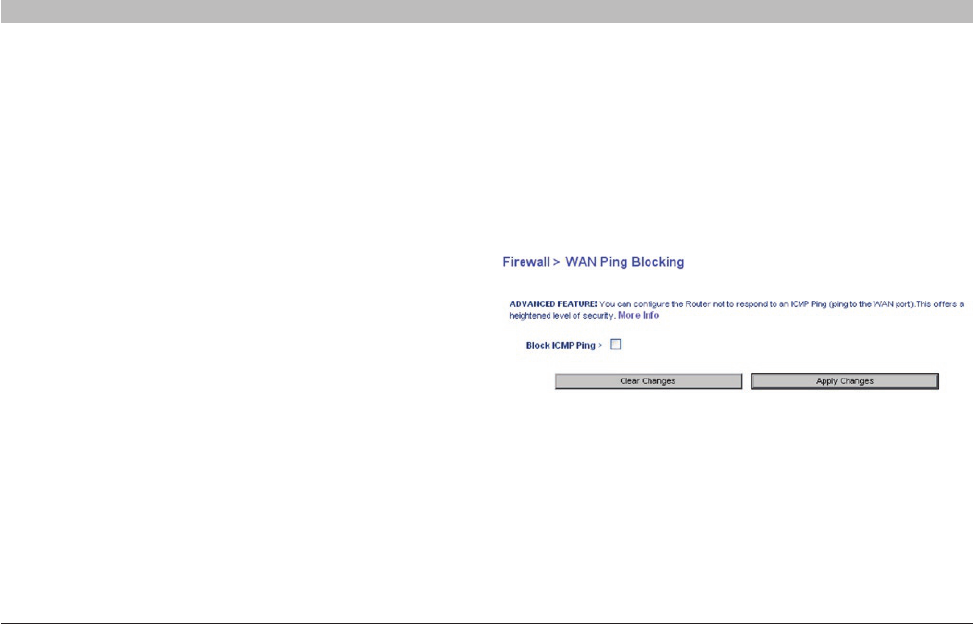
47
G Wireless Modem Router
SECTIONSTable of Contents 1234 6789105
MANUALLY CONFIGURING YOUR ROUTER
DMZ (Demilitarized Zone)
If you have a client PC that cannot run an Internet application properly
from behind the firewall, you can open the client up to unrestricted
2-way Internet access� This may be necessary if the NAT feature
is causing problems with an application such as a game or video-
conferencing application� Use this feature on a temporary basis� The
computer in the DMZ is not protected from hacker attacks�
To put a computer in the DMZ, enter the last digits of its IP address in
the IP field and select “Enable”� Click “Apply Changes” for the change
to take effect� If you are using multiple static WAN IP addresses, it
is possible to select to which WAN IP address the DMZ host will be
directed� Type in the WAN IP address to which you wish the DMZ host
to direct, enter the last two digits of the IP address of the DMZ host
computer, select “Enable”, and click “Apply Changes”�
Blocking an ICMP Ping
Computer hackers use what is known as “pinging” to find potential
victims on the Internet� By pinging a specific IP address and receiving a
response from the IP address, a hacker can determine that something of
interest might be there� The Router can be set up so it will not respond
to an ICMP ping from the outside� This heightens the level of security of
your Router�
To turn off the ping response, select “Block ICMP Ping” (1) and click
“Apply Changes”� The Router will not respond to an ICMP ping�
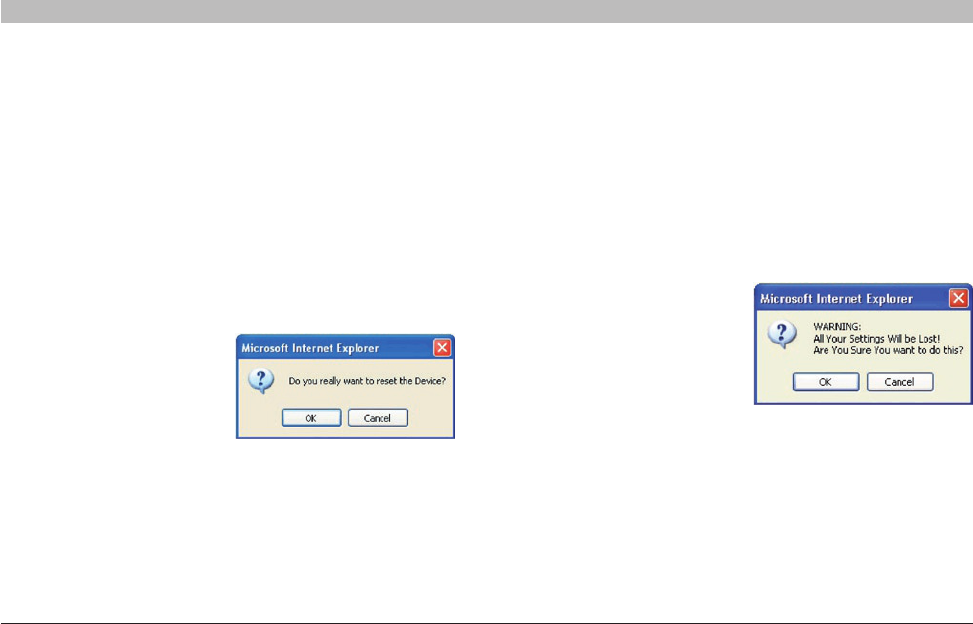
48
G Wireless Modem Router
SECTIONSTable of Contents 1234 6789105
MANUALLY CONFIGURING YOUR ROUTER
Utilities
The “Utilities” screen lets you manage different parameters of the Router and perform certain administrative functions�
Restart Router
At times it may be necessary to restart or reboot the Router if it begins
working improperly� Restarting or rebooting the Router will NOT delete
any of your configuration settings�
Restore Factory Defaults
Using this option will restore all of the settings in the Router to the
factory (default) settings� It is recommended that you back up your
settings before you restore all of the defaults�
Restarting the Router to Restore Normal Operation
1. Click the “Restart Router” button�
2. The following message will
appear� Click “OK” to restart
your Router�
1. Click the “Restore Defaults” button�
2. The following message
will appear� Click “OK” to
restore factory defaults�